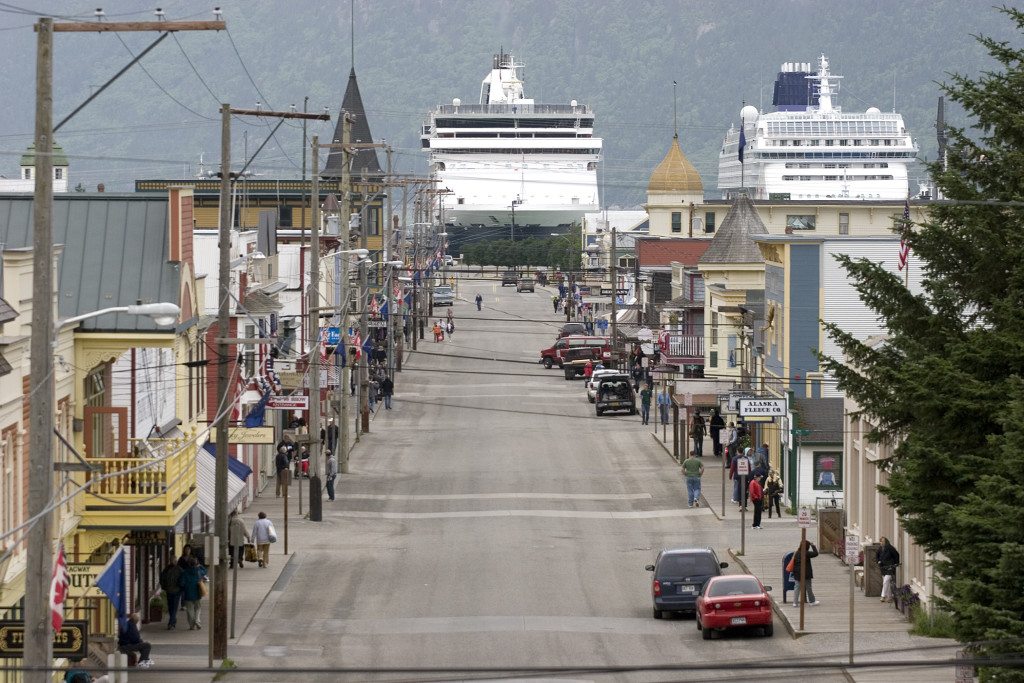Alaska charges cruise ships that stay three or more days in state waters a $34.50 tax per traveler. It’s called the Commercial Passenger Vessel Tax. The tax brings in millions of dollars each year, much of which the state distributes to cruise ship port communities. An audit of the CPV program found some towns need to tighten standards for how they spend the money. And, it alleged that Skagway misspent some CPV funds on school playground equipment.

The research was conducted by the state Division of the Legislative Audit after a request from Eagle River Senator Anna MacKinnon. MacKinnon wanted to get to the bottom of assertions that some communities stockpile CPV funds or use them on inappropriate projects.
While the audit didn’t find rampant abuse of CPV dollars, it did find one instance of misspent money and a couple cases where municipalities should do a better job justifying CPV expenditures.
The audit shows that Skagway receives more shared CPV funds from the state than any other town. From 2007 to 2015, the Gateway to the Klondike got more than $30 million. (That doesn’t include $10 million Skagway received in state CPV grant allocations.) Skagway and the other communities can’t just spend that money however they want. There are three things it can be used for: port facilities, harbor infrastructure or other services that provide for the cruise ships and their passengers.
“The audit found that shared tax revenue spent for port facilities and harbor infrastructure were allowable,” said Legislative Auditor Kris Curtis. “It was just the area where expenditures for other CPV services to vessels and passengers where they need to improve documentation.”
In Skagway’s case, Curtis said, one of those ‘other services’ purchases did not follow regulations.
“The municipality of Skagway borough management used CPV funds to purchase playground equipment for the Skagway elementary school at a cost of $114,450,” Curtis said. “The audit concluded that the playground equipment primarily used for the elementary school does not qualify as an allowable purpose under the state or federal law.”
“I wasn’t too sure about that,” said Skagway Borough Manager Scott Hahn.
Hahn was not at the helm when the playground purchase was made in 2013, but he says there is a justification for it.
“Skagway, unlike a lot of the larger communities, is very much different,” Hahn said. “Because you go to Juneau…when you add the cruise ship population it’s only a little bit of a dent in what’s going on there. But here it’s completely consumed by the cruise ship activity.”
Hahn’s argument is that in a town of less than 1,000 permanent residents, the up to 10,000 cruise ship passengers that pour into Skagway daily put a demand on resources that outweighs what other port towns experience. He said the school is a primary emergency shelter for cruise ship passengers. There’s also a huge influx of children in the summer with the arrival of seasonal workers and families of cruise ships.
“To me, if they weren’t here and you didn’t have families, it’s somewhat directly connected. But it all depends on how tightly you want to consider the impact,” Hahn said. “And in Skagway, the impact is overwhelming and all-consuming.”
Borough Treasurer Heather Rodig says records are unclear about why CPV funds were used on the playground equipment. She said it was a ‘prior management decision’ that was made before she or manager Hahn were in their current jobs. Borough Clerk Emily Deach said the playground supplies, were purchased for two parks – one at the school and one in downtown Skagway. It was the portion used for the school park that the audit found improper, Deach says.
Allowable expenditures by Skagway included improvements to the small boat harbor, which involved construction of a seawalk and wave barrier to enhance cruise visitor safety.
The other recommendations in the report have to do with Ketchikan and Sitka. Both places use CPV money for general municipal services. Curtis said the justifications to use CPV funds are vague.
“These communities where cruise ships are visiting, they certainly do encounter a great deal of increase in costs to services because of all the folks that offload onto communities,” Curtis said. “Our audit found that two specific communities were not doing an adequate job in supporting the degree to which cruise ship passengers increased general municipal costs as evidence to support using CPV taxes to pay for operations.”
Skagway also uses CPV funds for things like water, sewer and garbage costs. But the municipality was protected from admonishment on that front because of a survey conducted in 2008 that shows the cruise ship impact on municipal operations. The audit says that survey justifies the expenditures, although it would be more reliable if it was up-to-date.
Hahn said the borough assembly will discuss the CPV audit at a meeting this week.
“I think this is maybe just kind of a wake-up call to make sure everybody is doing the right thing,” Hahn said.
He said the audit will help Skagway’s government in future decisions to leverage CPV funds.
Emily Files is a reporter at KHNS in Haines.




